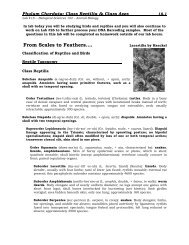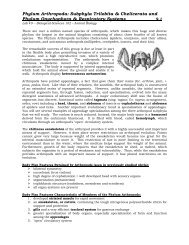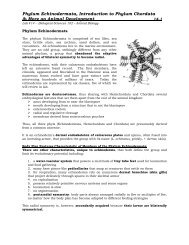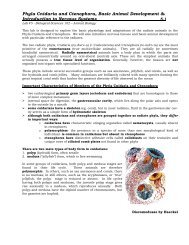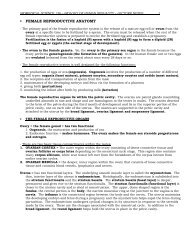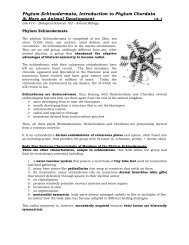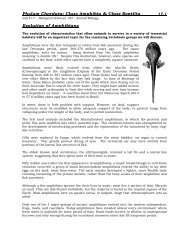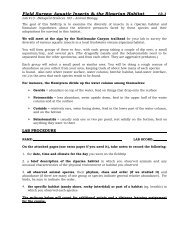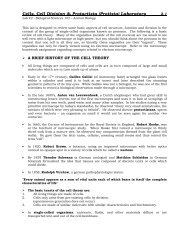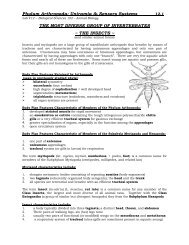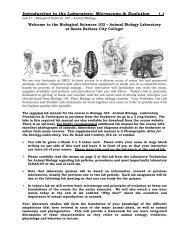Practice Quiz #1.1 for Exam #1 - Biosciweb.net
Practice Quiz #1.1 for Exam #1 - Biosciweb.net
Practice Quiz #1.1 for Exam #1 - Biosciweb.net
Create successful ePaper yourself
Turn your PDF publications into a flip-book with our unique Google optimized e-Paper software.
<strong>Practice</strong> <strong>Quiz</strong> <strong><strong>#1</strong>.1</strong> <strong>for</strong> First Lecture <strong>Exam</strong> 1Biological Sciences 102 – Animal BiologyQuestionsMultiple Choice1. Ribozymes are self-replicating molecules <strong>for</strong>med of which of the following macromolecules?A. DNAB. RNAC. carbohydrateD. proteinE. lipid2. Which of the following scientists put <strong>for</strong>ward an hypothesis that simple compounds inEarth’s very early environment were exposed to ultra-violet radiation and/or lightning and themixture of gases <strong>for</strong>med many simple organic molecules such as sugars and amino acids (someof the building blocks of life)?A. Alfred Russell WallaceB. Jean Baptiste de LamarckC. Edwin HubbleD. Alexander Oparin and J.B.S. HaldaneE. Robert Brown3. In which of the following cell organelles does transcription occur?A. cell nucleusB. rough endoplasmic reticulumC. Golgi apparatusD. lysosomeE. none of the above4. Which of the following trophic levels would contain organisms per<strong>for</strong>ming photosynthesis?A. primary consumerB. tertiary consumerC. secondary consumerD. decomposerE. primary producer5. Which of the following taxa contains the greatest number of different species?A. ClassB. FamilyC. GenusD. OrderE. Species6. Which of the following is the filter-feeding collar cell found in sponges?A. pinacocyteB. ameobocyteC. archaeocyteD. choanocyteE. none of the above
<strong>Practice</strong> <strong>Quiz</strong> <strong><strong>#1</strong>.1</strong> <strong>for</strong> First Lecture <strong>Exam</strong> 2Biological Sciences 102 – Animal Biology7. From the perspective of chemical structure, most enzymes found in cells are:A. polysaccharidesB. lipidsC. carbohydratesD. nucleic acidsE. proteinsFill-in-the-Blank8. Based on current cytological and biochemical evidence, what is the name of the theory thatdescribes the evolution of eukaryotic cells from prokaryotic cells?9. Of the three domains of life, which domain includes the ancient extremophile bacteria?10. List the three basic body plans/canal systems seen in members of the Phylum Porifera.Clearly indicate which is the most complex and which is the simplest body plan.1.2.3.11. What is ITIS an abbreviation <strong>for</strong>?12. Thelevel of the hierarchy of life refers to the all the interactionsbetween the various populations of different species in a particular area; all of the bioticinteractions in a particular habitat.Short Answer13. Briefly describe a savanna biome.14. How does latitudinal migration differ from altitudinal migration?15. How is the function of a mitochondrion dependent on the function of a chloroplast?16. How does osmosis differ from diffusion?
<strong>Practice</strong> <strong>Quiz</strong> <strong><strong>#1</strong>.1</strong> <strong>for</strong> First Lecture <strong>Exam</strong> 3Biological Sciences 102 – Animal BiologyAnswers1. B2. D3. A4. E5. A6. D7. E8. Theory of Endosymbiosis9. Archaea10. Asconoid = least complex; Syconoid; Leuconoid = most complex11. Integrated Taxonomic In<strong>for</strong>mation System12. Community Level13. A savanna is dominated by grasses and scattered trees. There is a fair amount of rainfallbut prolonged seasonal droughts are common and thus there is no <strong>for</strong>est. More varieties oflarge ungulates (like antelope) and their predators live here more than anywhere else.14. Both of these types of migration are typically seasonal. Latitudinal migration refers tomigration that occurs as animals move from one latitude to another (eg. north to south orsouth to north; not east to west) across the globe. Altitudinal migration refers to migrationfrom one altitude (topographical height) to another typically within a localized mountain range.15. Mitochondria require oxygen and glucose (or other molecules) made by chloroplasts.Mitochondria produce ATP and carbon dioxide and some water. Chloroplasts in turn needcarbon dioxide produced by mitochondria, water and sunlight to complete photosynthesis.16. Diffusion refers to a movement of molecules from an area of their higher concentration toan area of their lower concentration. Osmosis is the diffusion of a solvent (usually water)across a semi-permeable or selectively permeable membrane. This membrane only allowsspecific molecules to pass through usually based on molecular size and/or polarity (charge).



